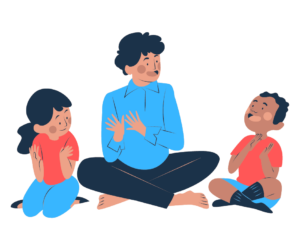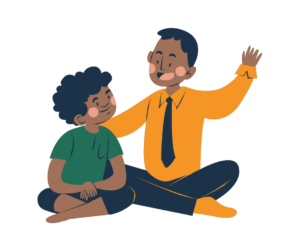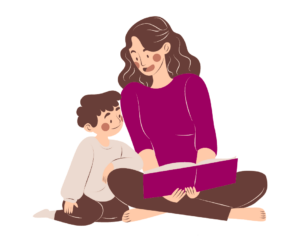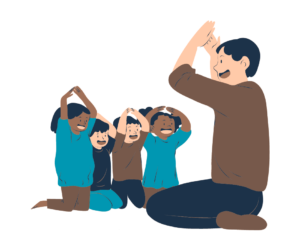Did you know that learning to read begins before children start school? From the time they are infants, children learn language and other important skills that will help them learn to read. Developing early literacy skills makes it easier for children to read once they do begin school.
That’s why many of our programs for small children at the Centerville Public Library are based on the national Every Child Ready to Read initiative. This simple literacy framework helps parents and caregivers prepare their children for school and reading through easy and fun daily activities. These activities are broken down into five categories : Singing, Talking, Reading, Writing, and Playing.
To help you get started, we’ve put together a big list of ideas for each category! Check them out!

SINGING
- Sing the alphabet song together to learn about letters.
- Sing nursery rhymes like “The Itsy Bitsy Spider.”
- Clap along to the rhythm in songs to help children hear the syllables.
- Sing spelling songs like B-I-N-G-O. Try it with your own names!
- Use empty bowls or cooking pots and wooden spoons as drums.
- Sing a lullaby before bed or a happy wake-up song in the morning. youtube.com/jbrary is a great resource!
- Play Freeze Dance—play some upbeat music and tell your child to stop moving every time you pause the music. Gradually play slower music to help your child wind down.
- Insert your child’s name and/or other family members’ names into songs and rhymes like “Mary Had a Little Lamb” or “Jack Be Nimble.”
- Sing a song like “This Is the Way We Wash” during bath time or a song like “Clean Up, Clean Up,” while picking up toys.

TALKING
- Name objects around your house with your child.
- Point to a picture of an animal and ask your child what sound it makes.
- Teach your child body part names while tickling them or getting them dressed.
- Point out different colors or shapes in a book. Ask your child to point to objects you name.
- Narrate your actions for your child when doing chores around the house.
- Stretch your child’s vocabulary. Repeat what your child says and use new words. “You want a banana? That’s a very healthy choice.” Or, “Yes, we did see a truck like that last week. It’s called a bulldozer.”
- Ask your child to retell a favorite story or a story you just read together.
- Take turns listing different types of things in a category (e.g., SHOES – sandals, sneakers, slippers, boots, etc.)
- Try to come up with as many words as you can that start with the same sound or letter.
- While your child plays with their toys, talk to them about the names of objects, their colors, their shapes, count them, etc.
- Recite nursery rhymes or fingerplays. Ask your librarian for suggestions.
- If your child is drawing a picture, ask them to tell you about it.

READING
- Read a bedtime story to your child.
- Read to your child while they eat a snack or play in the bathtub.
- Snuggle up with your child as you read a picture book together.
- Look at the cover of a book and ask your child to predict what the story might be about.
- As you read, ask your child to guess what happens next.
- Follow the text with your finger as you read with your child.
- Take a picture walk through a book before reading it, just to talk about the pictures, what you and your child think is happening, naming the objects in the pictures, etc.
- Read a book with flaps or textures your child can touch.
- Let your baby hold a board book and turn the pages on their own.
- Encourage your child to act out a book as you read it.
- Read a wordless picture book, describing what you see and/or asking your child to tell their own story. Your librarian can help you find one.
- While re-reading a favorite book, substitute silly words and help your child find the right word when they tell you it’s wrong.
- Give your child lots of opportunities to hold and interact with books on their own.

WRITING
- Give your child paper and crayons to scribble or color – this is the beginning of writing!
- Make edible finger paint by adding food coloring to Greek yogurt. Babies can paint directly on their highchair trays for easy cleanup!
- Draw some dashed lines on a blank piece of paper. Then give it to your child for them to trace.
- Write letters on the sidewalk with chalk. Give your child a big paintbrush and bowl of water and show them how to trace the letters with the wet paintbrush. Help them say the letters as they go. You can also practice numbers or shapes!
- Make your own sidewalk paint with food coloring and water! Put it in squeeze bottles or use paint brushes.
- Let your child watch you write a grocery list. Make a simple list with pictures and ask your child to cross off items as you shop.
- Show your child how to make lines and shapes in the sand or dirt using their finger or a stick.
- As your child learns to write letters, teach them how to write the letters in their name.
- Encourage your child to write their name on any pictures they draw or color.
- Talk to your child about what they are drawing and write captions or stories together.
- Help your child write notes for siblings or other family members and leave them somewhere as a surprise.

PLAYING
- Encourage dramatic play by using dress-up clothes, stuffed animals, and other props around your home.
- Act out familiar stories you’ve read together. Or put on a puppet show for siblings or other family members!
- Encourage your child to pretend to read a book to you or their stuffed animals or pets.
- Let your child help in the kitchen with simple and safe tasks like mixing and stirring.
- Help your child sort dirty clothes into piles by colors.
- Let your child play in the dirt while you do yard work.
- Write big letters on pieces of paper and have your child “swat” the letters with a fly swatter as you call them out.
- Blow bubbles and encourage your child to chase and catch them.
- Take your child for a walk in a park or your backyard. Talk to them about the different animals you see.
- Help your child hang and swing on monkey bars.
- Play “Peek-a-Boo” with a scarf or blanket. Hide toys under the blanket and ask your child to find them.
- Play with play-dough. Your child can even help you make your own with just a few pantry staples! Take a look: https://youtu.be/yl8c8ju4vLI
- Play a simple scavenger hunt with your child. Help them find things around the house or yard that you can sort into two different categories (smooth/rough; big/small; etc.).
- Play rhyming games. You say a word and ask your child to say another word that rhymes.
- Let your child use safety scissors to cut up paper. You can even make or print scissor sheets with dotted lines to follow.
- Give your child age-appropriate items to sort by size or color (e.g., craft pom poms, buttons, lids, pipe cleaners, etc.)
- Let your child play with magnetic letters on the refrigerator or a cookie sheet or with foam letters in the bathtub.
